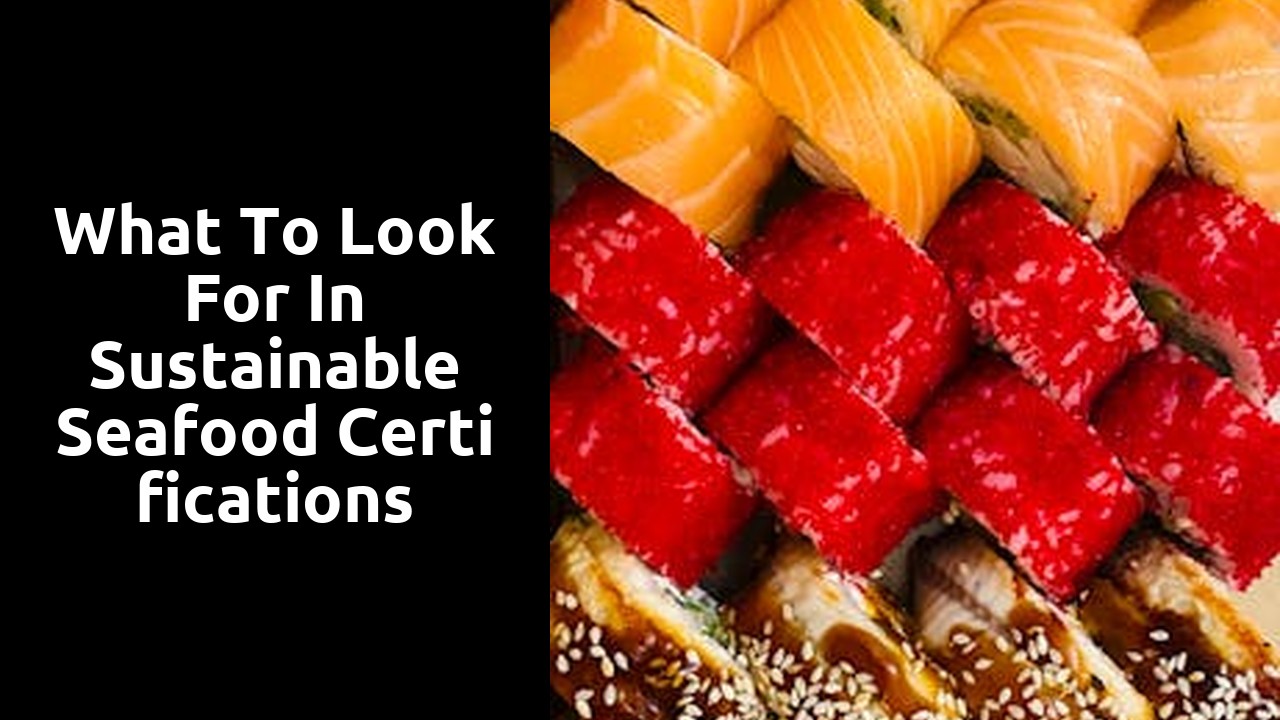What to Look for in Sustainable Seafood Certifications

Key Players in the Sustainable Seafood Certification Industry
The Sustainable Fisheries Partnership (SFP) is a prominent figure in the sustainable seafood certification industry. They work closely with industry stakeholders to assess and improve fisheries around the world. SFP's approach involves engaging with seafood suppliers, fishery managers, and government officials to promote sustainable practices and ensure the long-term health of fish stocks.
Another significant player in the field is the Marine Stewardship Council (MSC), an organisation that sets standards for sustainable fishing and seafood traceability. Through their certification programme, MSC recognises and rewards fisheries that demonstrate responsible fishing practices. By partnering with retailers and seafood companies, MSC aims to increase consumer awareness and demand for sustainably sourced seafood products.
Aquaculture Stewardship Council (ASC)
The Aquaculture Stewardship Council (ASC) is a notable organisation within the sustainable seafood certification industry. Established in 2010, ASC's primary objective is to drive positive change in aquaculture practices worldwide. By working closely with stakeholders, including producers, conservation groups, and scientists, ASC aims to promote responsible aquaculture that is both environmentally and socially sustainable.
ASC has developed a set of rigorous standards that farms must adhere to in order to receive certification. These standards cover a wide range of criteria, including water quality management, feed sourcing, and social welfare aspects. The ASC certification process involves independent assessments carried out by accredited auditing bodies, ensuring that farms meet the required criteria before being awarded the ASC logo.
Consumer Awareness and Understanding
Consumer awareness and understanding are pivotal in driving the demand for sustainable seafood products. As consumers become more conscious of their environmental impact, they are increasingly looking for seafood that is sourced responsibly. One way to communicate this to consumers is through clear labeling and certification symbols on seafood products. These symbols showcase the credibility of the certification and help shoppers make informed purchasing decisions.
Moreover, educating consumers about the importance of sustainable fishing practices and the impact of their choices on marine ecosystems is crucial. By raising awareness about the benefits of choosing certified sustainable seafood, consumers can have a direct impact on the industry. Through education and understanding, consumers can become advocates for sustainable seafood, influencing the market towards more ethical and environmentally friendly practices.
Labeling and Certification Symbols
When it comes to choosing sustainable seafood products, understanding the various labeling and certification symbols is crucial. These symbols provide consumers with a quick and easy way to identify which products meet certain environmental and ethical standards. For example, the blue MSC label, which stands for Marine Stewardship Council, signifies that the seafood has been sourced from a well-managed, sustainable fishery.
Another commonly seen symbol is the green tick from the Marine Conservation Society Good Fish Guide, indicating that the product is deemed sustainable by their standards. Additionally, the ASC logo, representing the Aquaculture Stewardship Council, is found on seafood products that come from farms that meet specific environmental and social criteria. By familiarising themselves with these symbols, consumers can make informed choices that support sustainable fishing practices and help preserve marine ecosystems for future generations.
Certification Standards and Regulations
Certification standards and regulations play a crucial role in ensuring the credibility and reliability of sustainable seafood certifications. These standards are set to uphold the principles of environmental sustainability, social responsibility, and traceability within the seafood industry. By adhering to these standards, seafood companies demonstrate their commitment to responsible practices and transparency in the sourcing and production of seafood products.
Regulations governing sustainable seafood certifications are designed to provide a framework for assessing and monitoring fisheries and aquaculture operations. These regulations often involve criteria related to stock levels, fishing methods, bycatch mitigation, and social welfare policies. By holding seafood producers accountable to these standards, certification bodies contribute to the preservation of marine ecosystems and the well-being of coastal communities dependent on fisheries. Compliance with these regulations is essential for maintaining the integrity and value of sustainable seafood certifications in the market.
Compliance and Enforcement Measures
Ensuring compliance with sustainable seafood standards is crucial in maintaining the integrity of certification schemes. Rigorous enforcement measures are essential to deter non-compliance and uphold the credibility of certifications. Robust auditing processes, site inspections, and traceability systems are integral components of effective enforcement strategies. These measures help to verify that seafood products meet the necessary sustainability criteria and prevent misleading claims.
Furthermore, when violations are identified, it is imperative that appropriate enforcement actions are taken. Penalties for non-compliance should act as a deterrent and encourage compliance with sustainability standards. This could include sanctions such as suspension or revocation of certification, fines, or public disclosure of violations. By implementing strong enforcement measures, sustainable seafood certifications can effectively promote responsible fishing practices and contribute to the long-term health of our oceans.
Related Links
Top 10 Sustainable Seafood Choices for ConsumersWhy Overfishing is a Threat to Wild Salmon Stocks
The History of Overfishing and Depletion of Wild Salmon Stocks
Review: The Environmental Impact of Aquaculture Practices
What Makes Wild Salmon Sustainable
Why Consumer Awareness is Key to Sustainable Seafood Choices